Using Multisource Geospatial Data to Identify Potential Wetland Rehabilitation Areas: A Pilot Study in China’s Sanjiang Plain
Abstract
1. Introduction
2. Materials and Methods
2.1. Study Area
2.2. Land Cover Dataset
2.3. Wetland Rehabilitation Indicator System Established from Multisource Geospatial Data
2.3.1. Wetlands Encroached by Agricultural Cultivation
2.3.2. Hydrologic Condition Characterized by the Current and Historical Distribution of Waterbodies
2.3.3. Topographical Characteristics by Digital Elevation Model (DEM)
2.3.4. Anthropogenic Threats Characterized by Built-Up Land Distribution
2.3.5. Ecological Conservation Levels Characterized by the Legislation for WNNR
2.4. Method for Determining Potential Wetland Rehabilitation Areas from Croplands
3. Results
3.1. Spatial Distribution of Land Cover in 2018
3.2. Wetland Loss Triggered by Cropland Expansion
3.3. Spatial Visualization of Wetland Rehabilitation Indicators
3.4. Pattern of Potential Wetland Rehabilitation Areas
4. Discussion
5. Conclusions
Author Contributions
Funding
Acknowledgments
Conflicts of Interest
References
- Millennium Ecosystem Assessment (MEA). Ecosystems and Human Well-Being: Wetlands and Water Synthesis; World Resources Institute: Washington, DC, USA, 2005. [Google Scholar]
- Wang, Z.; Wu, J.; Madden, M.; Mao, D. China’s Wetlands: Conservation Plans and Policy Impacts. AMBIO 2012, 41, 782–786. [Google Scholar] [CrossRef]
- Liu, R.; Wang, Q.; Wang, Y.; Zhang, L.; Shao, Z. Distribution of mercury in typical wetland plants in the Sanjiang plain. Chin. Geogr. Sci. 2003, 13, 242–246. [Google Scholar] [CrossRef]
- Davidson, N.C. How much wetland has the world lost? Long-term and recent trends in global wetland area. Mar. Freshw. Res. 2014, 65, 934. [Google Scholar] [CrossRef]
- Mao, D.; Wang, Z.; Wu, J.; Wu, B.; Zeng, Y.; Song, K.; Yi, K.; Luo, L. China’s wetlands loss to urban expansion. Land Degrad. Dev. 2018, 29, 2644–2657. [Google Scholar] [CrossRef]
- Cong, P.; Chen, K.; Qu, L.; Han, J. Dynamic Changes in the Wetland Landscape Pattern of the Yellow River Delta from 1976 to 2016 Based on Satellite Data. Chin. Geogr. Sci. 2019, 29, 372–381. [Google Scholar] [CrossRef]
- Kumari, R.; Shukla, S.K.; Parmar, K.; Bordoloi, N.; Kumar, A.; Saikia, P. Wetlands Conservation and Restoration for Ecosystem Services and Halt Biodiversity Loss: An Indian Perspective. In Restoration of Wetland Ecosystem: A Trajectory Towards a Sustainable Environment; Upadhyay, A.K., Singh, R., Singh, D.P., Eds.; Springer: Singapore, 2020; pp. 75–85. ISBN 9789811376641. [Google Scholar]
- Man, W.; Yu, H.; Li, L.; Liu, M.; Mao, D.; Ren, C.; Wang, Z.; Jia, M.; Miao, Z.; Lu, C.; et al. Spatial Expansion and Soil Organic Carbon Storage Changes of Croplands in the Sanjiang Plain, China. Sustainability 2017, 9, 563. [Google Scholar] [CrossRef]
- Saunders, M.J.; Kansiime, F.; Jones, M.B. Agricultural encroachment: Implications for carbon sequestration in tropical African wetlands. Glob. Chang. Biol. 2012, 18, 1312–1321. [Google Scholar] [CrossRef]
- Maleki, S.; Soffianian, A.R.; Koupaei, S.S.; Pourmanafi, S.; Saatchi, S. Wetland restoration prioritizing, a tool to reduce negative effects of drought; An application of multicriteria-spatial decision support system (MC-SDSS). Ecol. Eng. 2018, 112, 132–139. [Google Scholar] [CrossRef]
- Russell, G.D.; Hawkins, C.P.; O’Neill, M.P. The Role of GIS in Selecting Sites for Riparian Restoration Based on Hydrology and Land Use. Restor. Ecol. 1997, 5, 56–68. [Google Scholar] [CrossRef]
- Acreman, M.C.; Fisher, J.; Stratford, C.J.; Mould, D.J.; Mountford, J.O. Hydrological science and wetland restoration: Some case studies from Europe. Hydrol. Earth Syst. Sci. 2007, 11, 158–169. [Google Scholar] [CrossRef]
- Huang, N.; Wang, Z.; Liu, D.; Niu, Z. Selecting Sites for Converting Farmlands to Wetlands in the Sanjiang Plain, Northeast China, Based on Remote Sensing and GIS. Environ. Manag. 2010, 46, 790–800. [Google Scholar] [CrossRef] [PubMed]
- Guan, B.; Chen, M.; Elsey-Quirk, T.; Yang, S.; Shang, W.; Li, Y.; Tian, X.; Han, G. Soil seed bank and vegetation differences following channel diversion in the Yellow River Delta. Sci. Total Environ. 2019, 693, 133600. [Google Scholar] [CrossRef] [PubMed]
- Pakeman, R.J.; Small, J.L. The role of the seed bank, seed rain and the timing of disturbance in gap regeneration. J. Veg. Sci. 2005, 16, 121–130. [Google Scholar] [CrossRef]
- Van Asselen, S.; Verburg, P.H.; Vermaat, J.E.; Janse, J.H. Drivers of Wetland Conversion: A Global Meta-Analysis. PLoS ONE 2013, 8, e81292. [Google Scholar] [CrossRef]
- Mao, D.; Luo, L.; Wang, Z.; Wilson, M.C.; Zeng, Y.; Wu, B.; Wu, J. Conversions between natural wetlands and farmland in China: A multiscale geospatial analysis. Sci. Total Environ. 2018, 634, 550–560. [Google Scholar] [CrossRef]
- Klemas, V. Remote Sensing of Wetlands: Case Studies Comparing Practical Techniques. J. Coast. Res. 2011, 27, 418. [Google Scholar]
- Adam, E.; Mutanga, O.; Rugege, D. Multispectral and hyperspectral remote sensing for identification and mapping of wetland vegetation: A review. Wetl. Ecol. Manag. 2010, 18, 281–296. [Google Scholar] [CrossRef]
- Xiang, H.; Wang, Z.; Mao, D.; Zhang, J.; Xi, Y.; Du, B.; Zhang, B. What did China’s National Wetland Conservation Program Achieve? Observations of changes in land cover and ecosystem services in the Sanjiang Plain. J. Environ. Manag. 2020, 267, 110623. [Google Scholar] [CrossRef]
- Mao, D.; He, X.; Wang, Z.; Tian, Y.; Xiang, H.; Yu, H.; Man, W.; Jia, M.; Ren, C.; Zheng, H. Diverse policies leading to contrasting impacts on land cover and ecosystem services in Northeast China. J. Clean. Prod. 2019, 240, 117961. [Google Scholar] [CrossRef]
- Song, K.; Wang, Z.; Du, J.; Liu, L.; Zeng, L.; Ren, C. Wetland Degradation: Its Driving Forces and Environmental Impacts in the Sanjiang Plain, China. Environ. Manag. 2014, 54, 255–271. [Google Scholar] [CrossRef]
- Wang, Z.; Mao, D.; Li, L.; Jia, M.; Dong, Z.; Miao, Z.; Ren, C.; Song, C. Quantifying changes in multiple ecosystem services during 1992–2012 in the Sanjiang Plain of China. Sci. Total Environ. 2015, 514, 119–130. [Google Scholar] [CrossRef] [PubMed]
- Mao, D.; Wang, Z.; Du, B.; Li, L.; Tian, Y.; Jia, M.; Zeng, Y.; Song, K.; Jiang, M.; Wang, Y. National wetland mapping in China: A new product resulting from object-based and hierarchical classification of Landsat 8 OLI images. ISPRS J. Photogramm. Remote Sens. 2020, 164, 11–25. [Google Scholar] [CrossRef]
- Du, B.; Zheng, Y.; Liu, J.; Mao, D. Threatened Plants in China’s Sanjiang Plain: Hotspot Distributions and Gap Analysis. Sustainability 2018, 10, 194. [Google Scholar] [CrossRef]
- Zhang, L.; Li, X.; Yuan, Q.; Liu, Y. Object-based approach to national land cover mapping using HJ satellite imagery. J. Appl. Remote Sens. 2014, 8, 083686. [Google Scholar] [CrossRef]
- Stroh, P.A.; Hughes, F.M.R.; Sparks, T.H.; Mountford, J.O. The Influence of Time on the Soil Seed Bank and Vegetation across a Landscape-Scale Wetland Restoration Project. Restor. Ecol. 2012, 20, 103–112. [Google Scholar] [CrossRef]
- Wang, G.; Wang, M.; Lu, X.; Jiang, M. Effects of farming on the soil seed banks and wetland restoration potential in Sanjiang Plain, Northeastern China. Ecol. Eng. 2015, 77, 265–274. [Google Scholar] [CrossRef]
- Dekker, S.C.; Barendregt, A.; Bootsma, M.C.; Schot, P.P. Modelling hydrological management for the restoration of acidified floating fens. Hydrol. Process. 2005, 19, 3973–3984. [Google Scholar] [CrossRef]
- Hua, Y.; Cui, B.; He, W.; Cai, Y. Identifying potential restoration areas of freshwater wetlands in a river delta. Ecol. Indic. 2016, 71, 438–448. [Google Scholar] [CrossRef]
- Diefenderfer, H.L.; Sinks, I.A.; Zimmerman, S.A.; Cullinan, V.I.; Borde, A.B. Designing topographic heterogeneity for tidal wetland restoration. Ecol. Eng. 2018, 123, 212–225. [Google Scholar] [CrossRef]
- Murray, N.J.; Clemens, R.S.; Phinn, S.R.; Possingham, H.P.; Fuller, R.A. Tracking the rapid loss of tidal wetlands in the Yellow Sea. Front. Ecol. Environ. 2014, 12, 267–272. [Google Scholar] [CrossRef]
- Li, Z.; Zhang, Z.; Xue, Z.; Song, X.; Zhang, H.; Wu, H.; Jiang, M.; Lyu, X. Molecular Fingerprints of Soil Organic Matter in a Typical Freshwater Wetland in Northeast China. Chin. Geogr. Sci. 2019, 29, 700–708. [Google Scholar] [CrossRef]
- Yan, F.; Zhang, S. Ecosystem service decline in response to wetland loss in the Sanjiang Plain, Northeast China. Ecol. Eng. 2019, 130, 117–121. [Google Scholar] [CrossRef]
- Zheng, X.; Fu, J.; Ramamonjisoa, N.; Zhu, W.; He, C.; Lu, C. Relationship between Wetland Plant Communities and Environmental Factors in the Tumen River Basin in Northeast China. Sustainability 2019, 11, 1559. [Google Scholar] [CrossRef]
- Wang, G.-P.; Zhai, Z.-L.; Liu, J.-S.; Wang, J.-D. Forms and profile distribution of soil phosphorus in four wetlands across gradients of sand desertification in Northeast China. Geoderma 2008, 145, 50–59. [Google Scholar] [CrossRef]
- Cyranoski, D. Putting China’s wetlands on the map. Nature 2009, 458, 134. [Google Scholar] [CrossRef] [PubMed]
- Niu, Z.; Gong, P.; Cheng, X.; Guo, J.; Wang, L.; Huang, H.; Shen, S.; Wu, Y.; Wang, X.; Wang, X.; et al. Geographical characteristics of China’s wetlands derived from remotely sensed data. Sci. China Ser. D-Earth Sci. 2009, 52, 723–738. [Google Scholar] [CrossRef]
- Meng, B.; Liu, J.; Bao, K.; Sun, B. Methodologies and management framework for restoration of wetland hydrologic connectivity: A synthesis. Integr. Environ. Assess. Manag. 2020, 16, 438–451. [Google Scholar] [CrossRef]
- Rebelo, A.J.; Le Maitre, D.C.; Esler, K.J.; Cowling, R.M. Hydrological responses of a valley-bottom wetland to land-use/land-cover change in a South African catchment: Making a case for wetland restoration: Wetland hydrological response to land-cover change. Restor. Ecol. 2015, 23, 829–841. [Google Scholar] [CrossRef]
- Wang, Z.; Huang, N.; Luo, L.; Li, X.; Ren, C.; Song, K.; Chen, J.M. Shrinkage and fragmentation of marshes in the West Songnen Plain, China, from 1954 to 2008 and its possible causes. Int. J. Appl. Earth Obs. Geoinf. 2011, 13, 477–486. [Google Scholar] [CrossRef]
- Jia, M.; Wang, Z.; Wang, C.; Mao, D.; Zhang, Y. A New Vegetation Index to Detect Periodically Submerged Mangrove Forest Using Single-Tide Sentinel-2 Imagery. Remote Sens. 2019, 11, 2043. [Google Scholar] [CrossRef]
- Doran, J.W.; Kirschenmann, F.; Magdoff, F. Balancing food, environmental and resource needs. Renew. Agric. Food Syst. 2007, 22, 77–79. [Google Scholar] [CrossRef][Green Version]
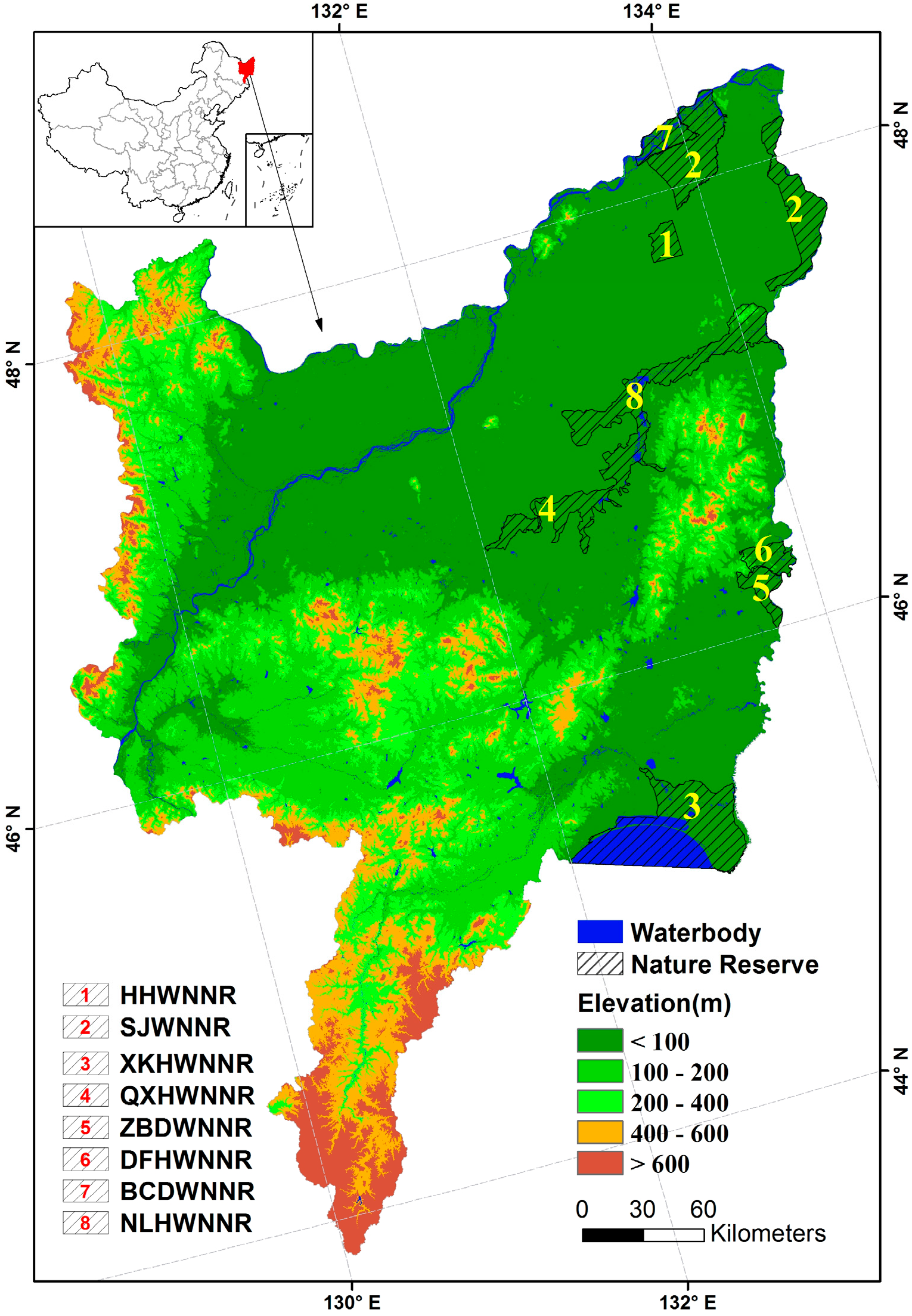

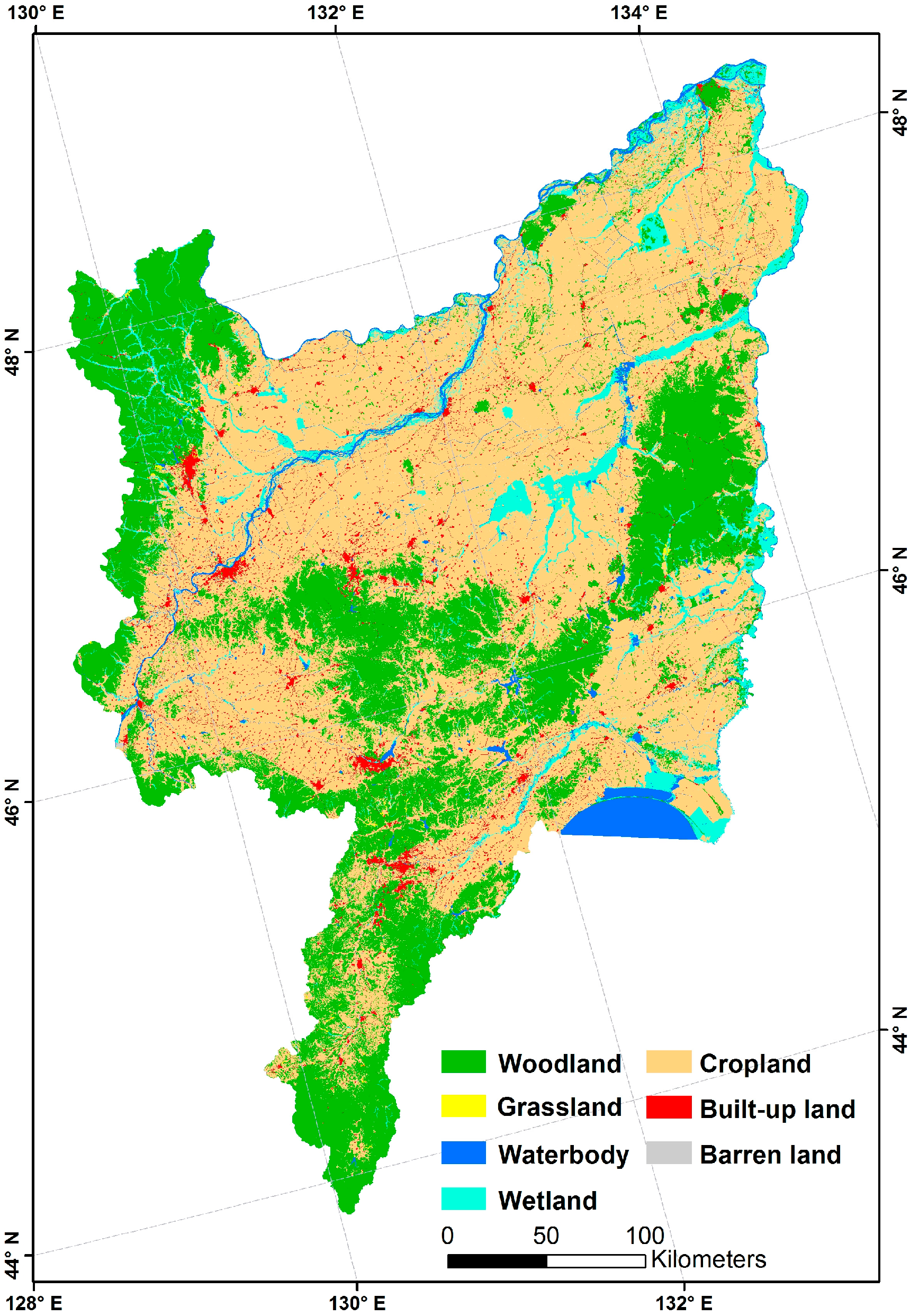

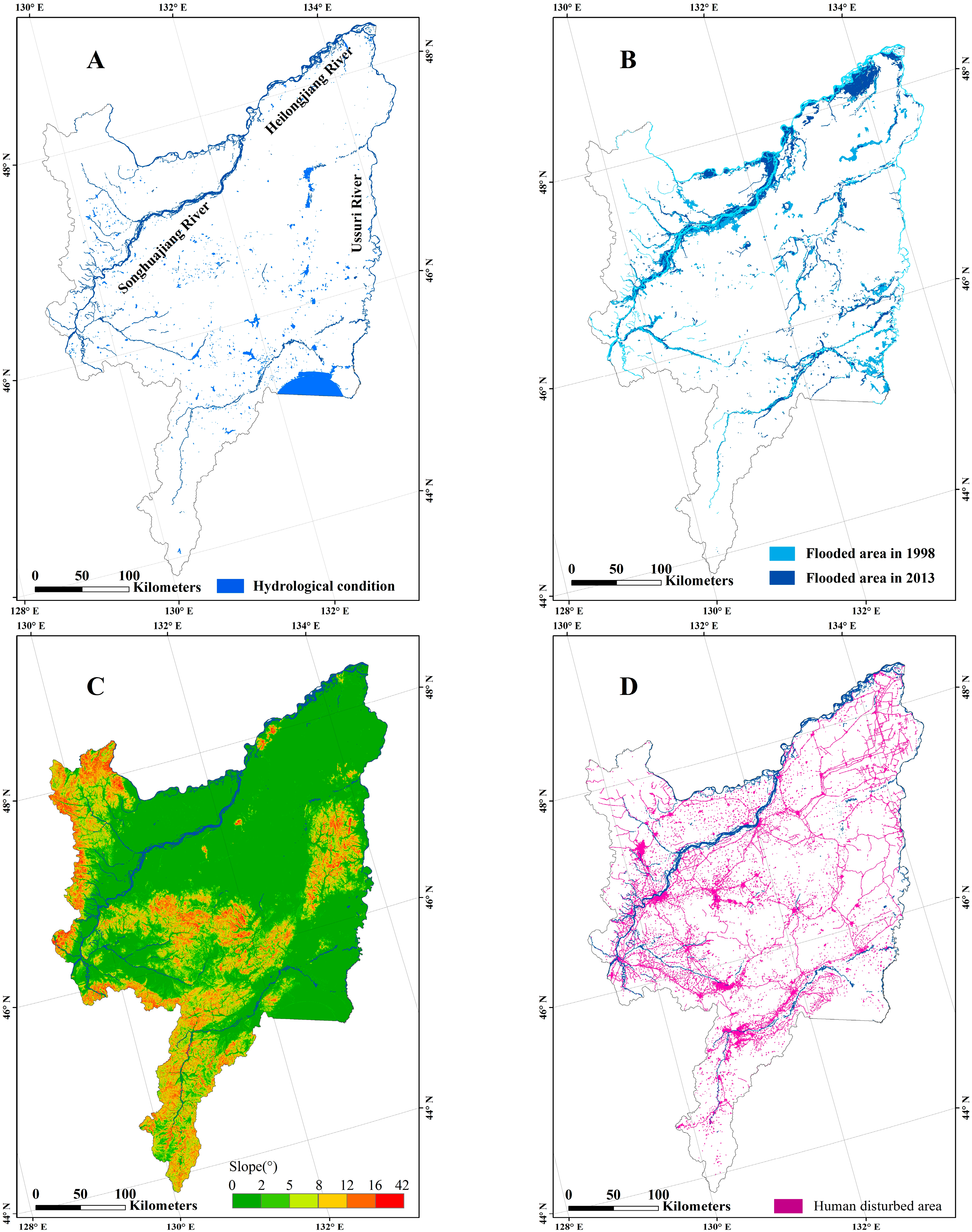
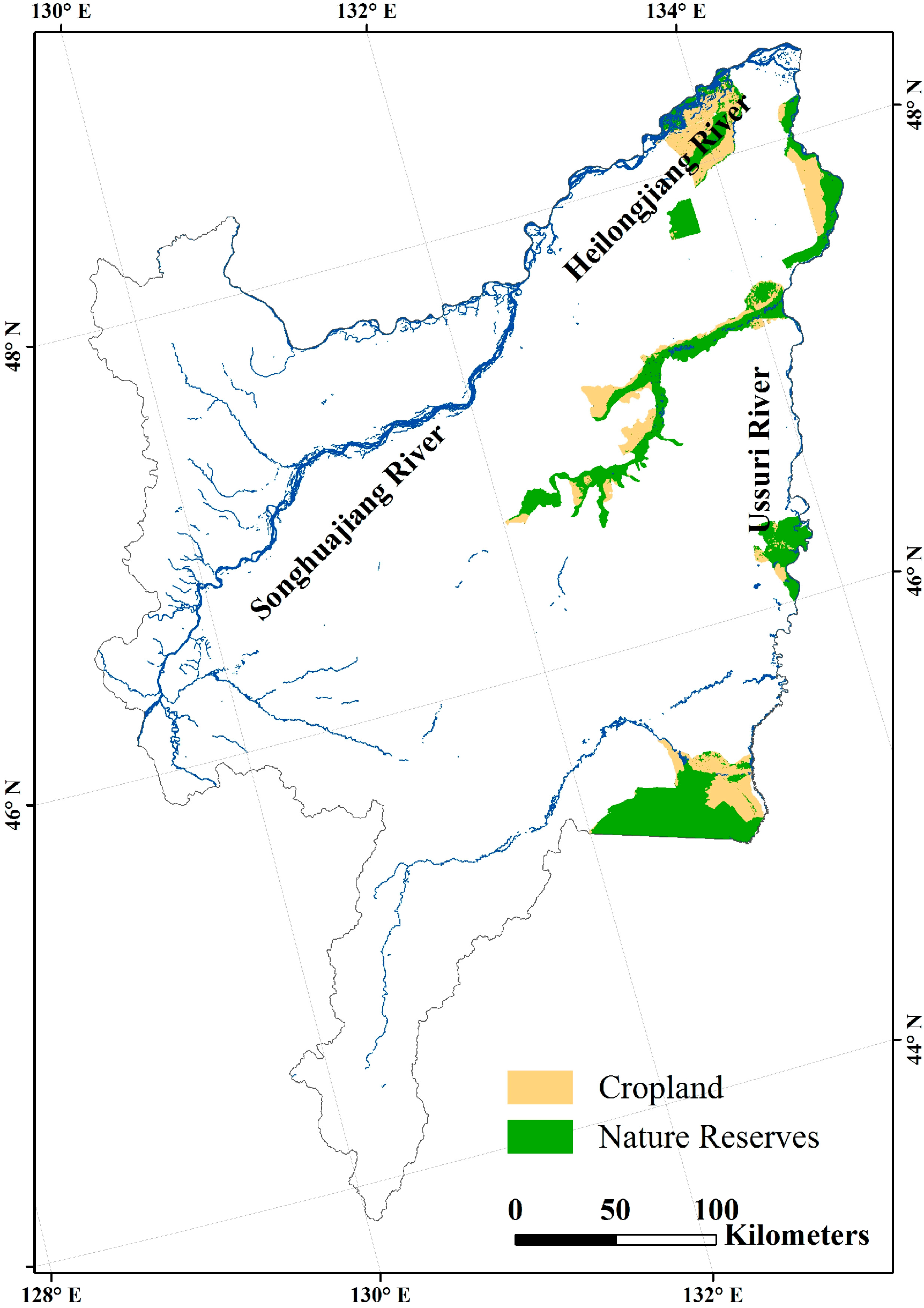
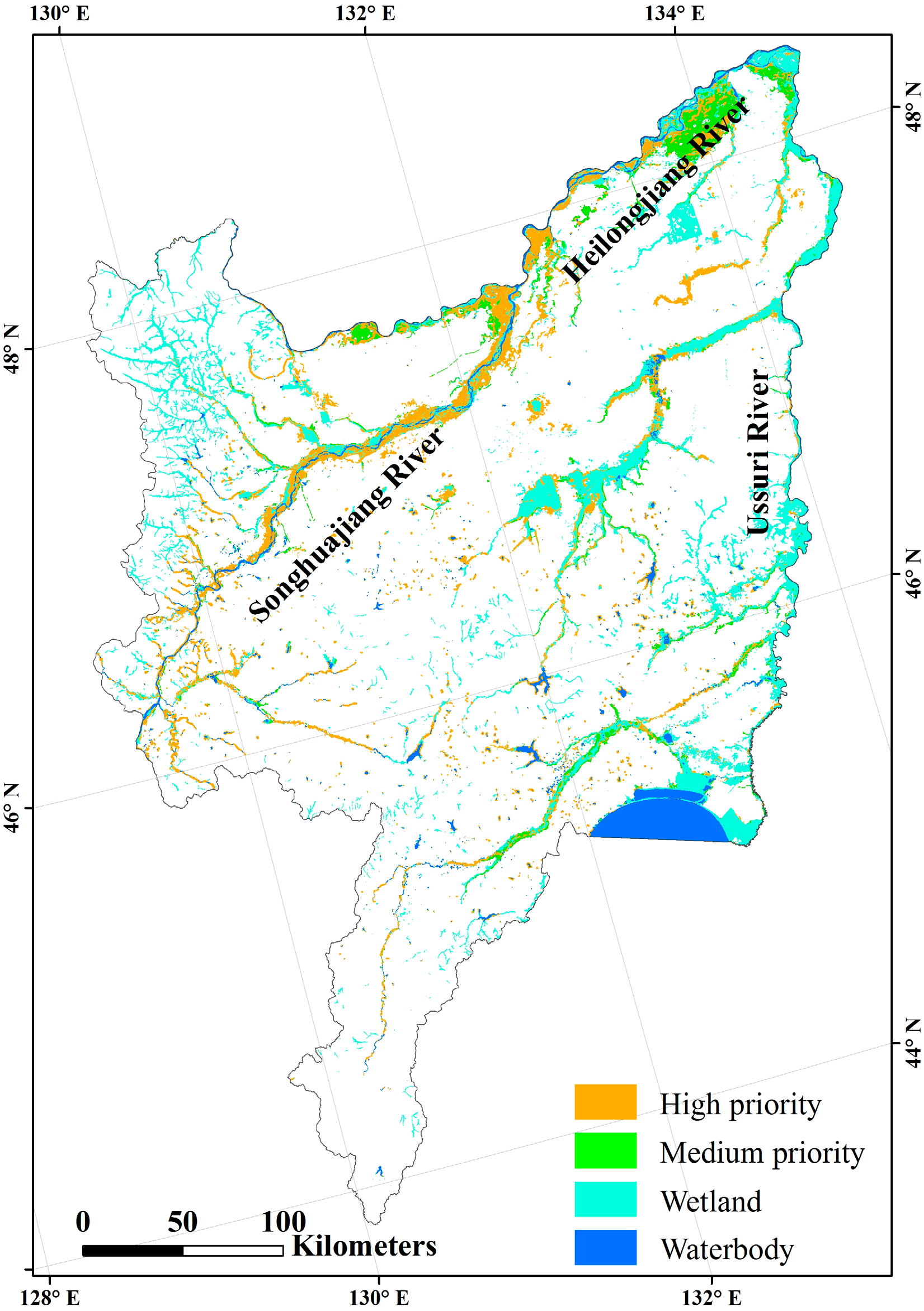
| Indicator | Constraint Condition | Threshold for Prioritizing |
| Wetlands encroached by agricultural cultivation | Cultivation history shorter than 10 years | High: cultivation history in 2008–2018 Medium: cultivation history in 1990–2008 |
| Hydrological condition | Open waterbody; flooded area | High: waterbody in 2018 with 300-m buffer, flooded in 1998 Medium: flooded in 2013 |
| Topographical characteristics | Slope > 5°, exclude; Slope ≤ 5°, retain | Filter indicator for generated dataset layer |
| Anthropogenic disturbance | Built-up land | Filter indicator for generated dataset layer |
| Ecological conservation | Cropland in WNNRs | High: cropland in core and buffer zone Medium: cropland in experimental zone |
| Wetlands Lost to Cropland Expansion | 1990–2000 | 2000–2008 | 2008–2013 | 2013–2018 |
|---|---|---|---|---|
| Area (km2) | 7384 | 2312 | 719 | 1228 |
| Contribution of cropland expansion to wetland loss (%) | 93 | 82 | 65 | 80 |
| Reserve Name | Core Zone | Buffer Zone | Experimental Zone | Total |
|---|---|---|---|---|
| (km2) | (km2) | (km2) | (km2) | |
| ZBDWNNR | 23 | 34 | 54 | 111 |
| DFHWNNR | 8 | 10 | 5 | 23 |
| BCDWNNR | 2 | 3 | 83 | 88 |
| SJWNNR | 171 | 135 | 886 | 1192 |
| NLHWNNR | 83 | 302 | 608 | 993 |
| XKHWNNR | 65 | 0 | 630 | 695 |
| QXHWNNR | 0 | 5 | 30 | 35 |
| HHWNNR | 0 | 3 | 3 | 6 |
| Area (km2) | High | Medium | Total | |||
|---|---|---|---|---|---|---|
| Dry farmland | 2547 | 4193 | 872 | 1222 | 3419 | 5415 |
| Paddy field | 1646 | 350 | 1996 | |||
© 2020 by the authors. Licensee MDPI, Basel, Switzerland. This article is an open access article distributed under the terms and conditions of the Creative Commons Attribution (CC BY) license (http://creativecommons.org/licenses/by/4.0/).
Share and Cite
Qiu, Z.; Luo, L.; Mao, D.; Du, B.; Feng, K.; Jia, M.; Wang, Z. Using Multisource Geospatial Data to Identify Potential Wetland Rehabilitation Areas: A Pilot Study in China’s Sanjiang Plain. Water 2020, 12, 2496. https://doi.org/10.3390/w12092496
Qiu Z, Luo L, Mao D, Du B, Feng K, Jia M, Wang Z. Using Multisource Geospatial Data to Identify Potential Wetland Rehabilitation Areas: A Pilot Study in China’s Sanjiang Plain. Water. 2020; 12(9):2496. https://doi.org/10.3390/w12092496
Chicago/Turabian StyleQiu, Zhiqiang, Ling Luo, Dehua Mao, Baojia Du, Kaidong Feng, Mingming Jia, and Zongming Wang. 2020. "Using Multisource Geospatial Data to Identify Potential Wetland Rehabilitation Areas: A Pilot Study in China’s Sanjiang Plain" Water 12, no. 9: 2496. https://doi.org/10.3390/w12092496
APA StyleQiu, Z., Luo, L., Mao, D., Du, B., Feng, K., Jia, M., & Wang, Z. (2020). Using Multisource Geospatial Data to Identify Potential Wetland Rehabilitation Areas: A Pilot Study in China’s Sanjiang Plain. Water, 12(9), 2496. https://doi.org/10.3390/w12092496








